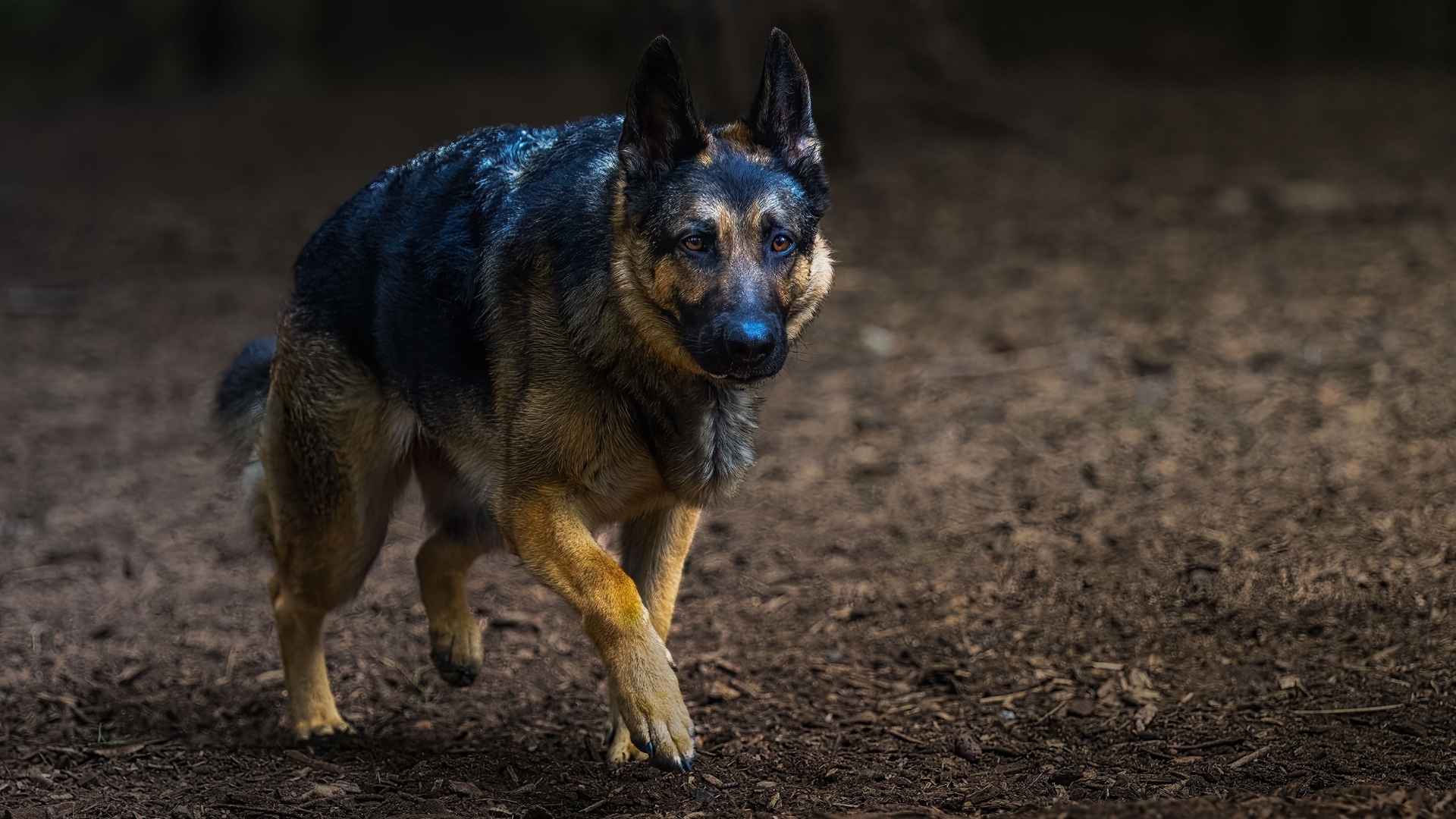Certain dog breeds possess an extraordinary level of vigilance and sensory awareness, making them ideal companions on late‑night walks. These breeds are naturally observant, quickly detecting subtle changes in their surroundings.
Some carry formal training from lines bred for protection, while others inherited their alertness through centuries of duty as sentinels or monastery guardians. Whether listening for faint footsteps, noticing shifts in light or shadow, or responding instinctively to unfamiliar scents, these dogs stay alert without drama or fear.
Their behavior is shaped by intelligence, loyalty, and an inheritance of watchful vigilance. Equipped with strong hearing, sharp vision, and a readiness to act, they provide an added layer of confidence during nighttime outings.
In the following sections, seven dog breeds with a proven record of staying alert during late‑night walks will be highlighted, with attention to their traits, background, and suitability for nocturnal companionship.
Dog Breeds That Stay Alert During Late-Night Walks
1. Belgian Malinois
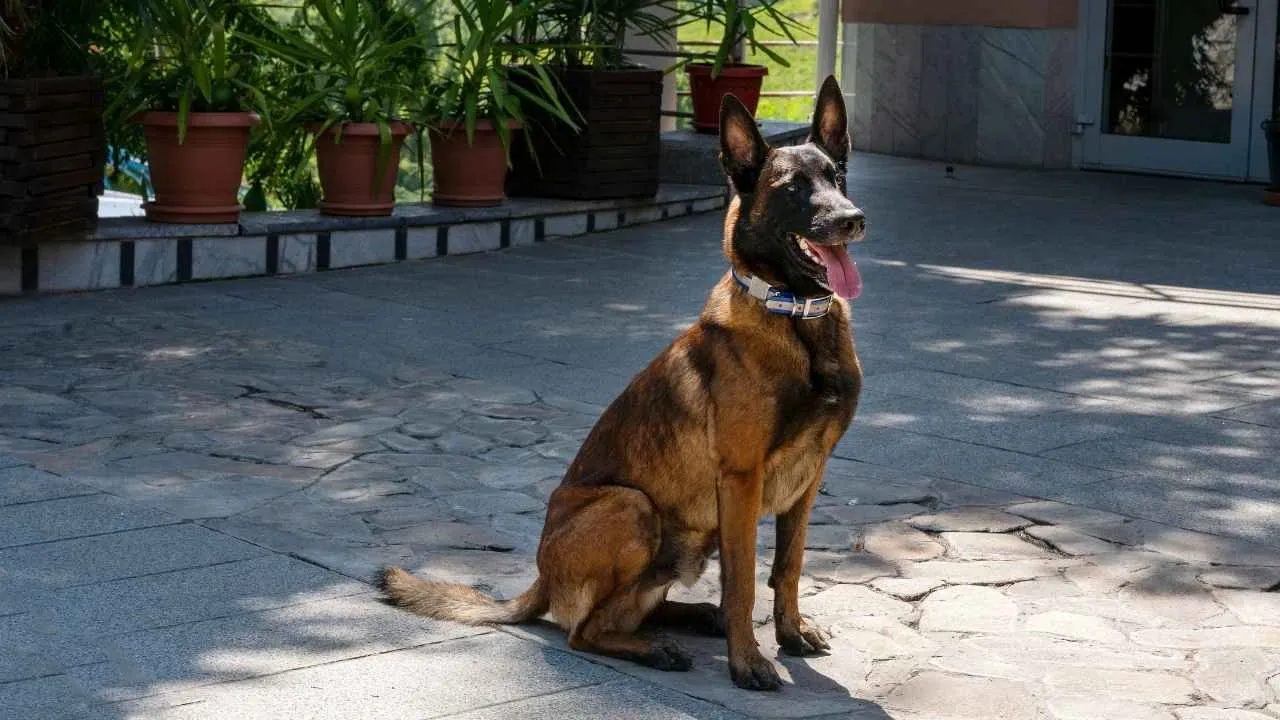
The Belgian Malinois is a high‑drive working dog known for its speed, strength, and unwavering attentiveness. Its lean, muscular build and sharp senses allow it to pick up faint sounds or movements in the dark. Many come from lines bred for demanding jobs, which gives them a natural capacity for focus and precision.
This breed shows an intense loyalty to its handler and tends to form deep bonds with a single family. Its temperament leans toward confident and task‑oriented, with a calm but ready posture when observing the environment. Consistent exercise, advanced obedience drills, and mental stimulation are essential to keep its mind sharp and engaged.
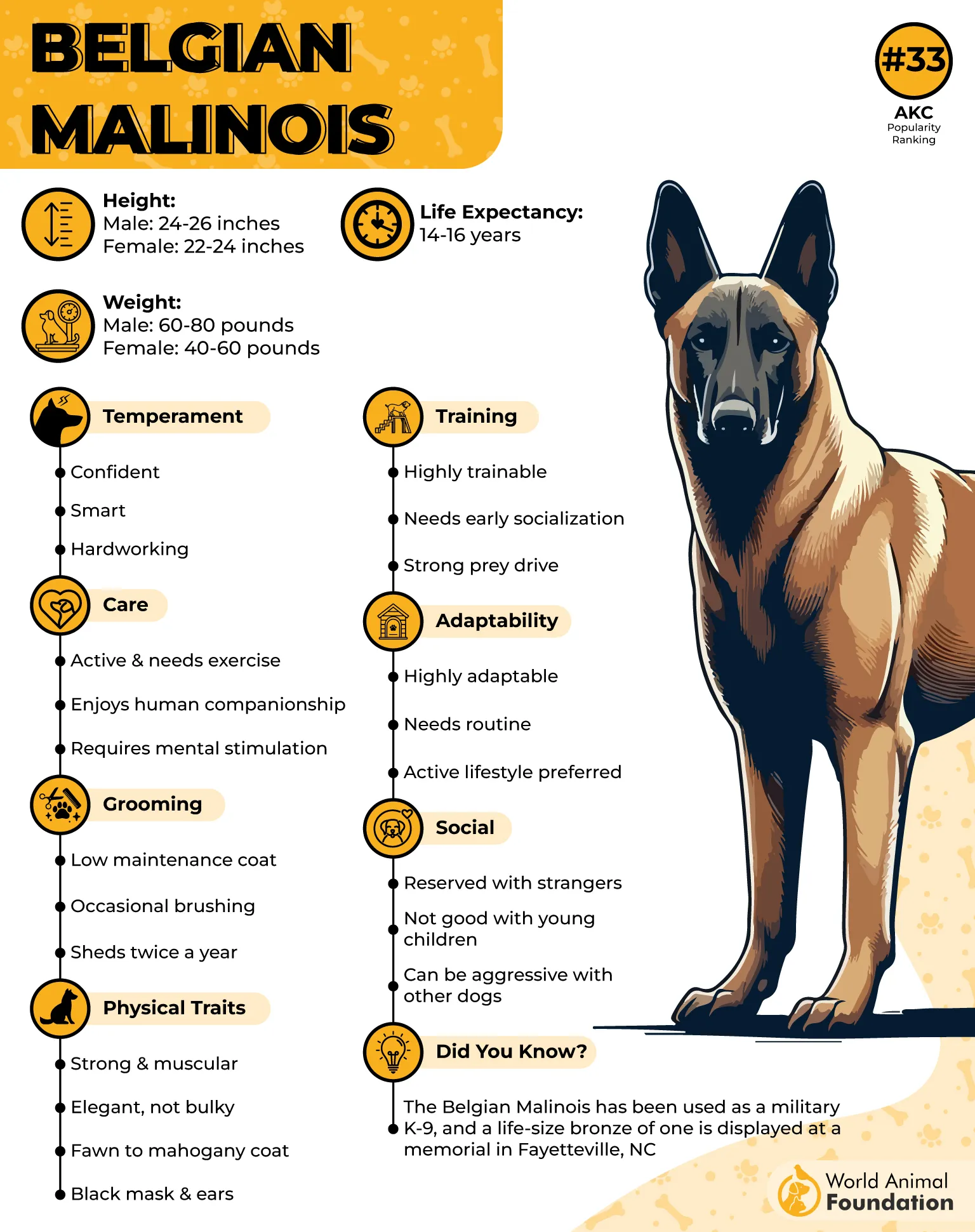
The coat is short and weather‑resistant, shedding lightly throughout the year with seasonal spikes in fur loss. Weekly brushing, occasional baths, and attention to nails and teeth maintain its clean, practical look. The double coat protects well in various conditions, including damp or cool evenings.
According to the AKC, early socialization and structured training help balance the breed’s strong protective instinct. They respond best to steady, positive reinforcement methods that build trust rather than confrontation. A Belgian Malinois without mental outlets may turn restless or develop destructive habits indoors.
Responsible breeders monitor for hip and elbow dysplasia, progressive retinal atrophy, and epilepsy. Their typical lifespan runs 10 to 14 years, and a high‑protein diet supports their demanding energy needs.
Fun Fact
Belgian Malinois are nicknamed “Maligators,” a playful nod to their gripping bite strength and intense drive.
2. German Shepherd

Strength and balance define the German Shepherd, a breed refined for decades to excel in roles ranging from herding to modern service work. Its frame is powerful without bulk, built for agility as much as strength. The natural focus in its eyes suggests a dog that reads every movement around it.
This breed bonds deeply with those it trusts, often showing an unwavering connection to one person in particular. A protective streak appears early in life, and careful socialization turns that raw instinct into measured, reliable behavior. They carry that vigilance into nighttime settings, staying attentive to shifts in sound or motion even in low light.

As per PetMD, German Shepherds thrive under routine and purpose. They welcome structured challenges like scent tracking, agility drills, or obedience practice, activities that work the mind as much as the body. Without these outlets, they may grow unsettled and invent their own diversions.
The dense double coat is both functional and demanding, shedding lightly most of the year and heavily during seasonal changes. Brushing several times a week keeps fur manageable, while nail trimming and dental care round out their upkeep. These habits keep the breed in peak condition through years of activity.
Joint health is an important consideration, as hip and elbow dysplasia remain known risks. Degenerative myelopathy and certain allergies also occur, with attentive veterinary care making a clear difference over time.
Fun Fact
The very first German Shepherd to be officially registered, Horand von Grafrath, became the ancestor of nearly every German Shepherd alive today.
3. Rottweiler

A Rottweiler on a quiet street at night is rarely distracted. This is a breed that assesses its surroundings with a calm, measured gaze, picking up changes in posture, sound, and movement before anyone else reacts. That steady presence is one of the reasons Rottweilers have been trusted for centuries to guard property and people.
They respond best to work that has structure and purpose. Pulling carts, practicing obedience, or doing controlled protection drills engages their mind as much as their powerful body. Endless running isn’t necessary; what they value is a task to complete.
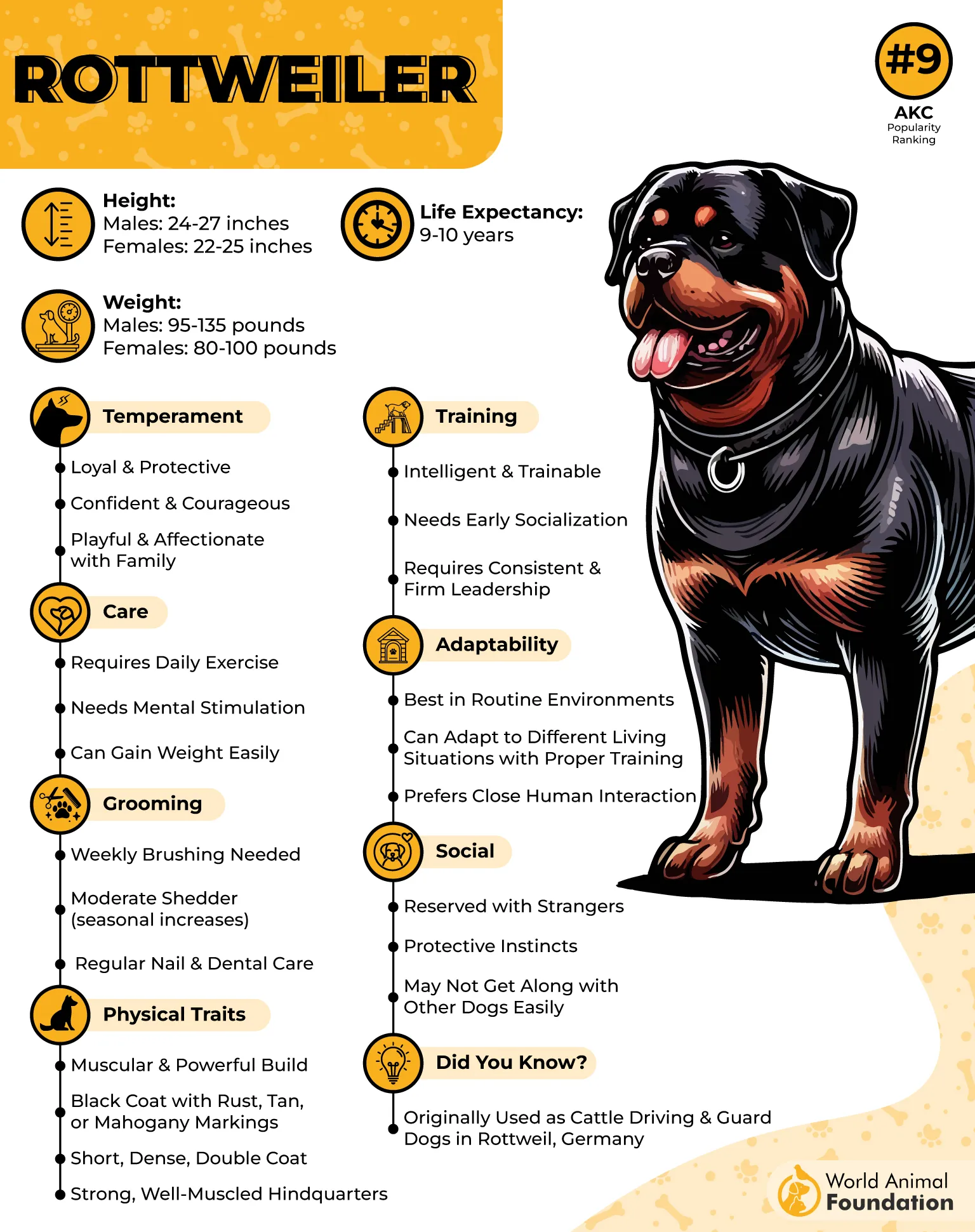
Training has to be consistent from the start. Their intelligence means they learn quickly, but it also means they notice gaps in rules or unclear commands. Rottweilers respect calm authority and thrive when they know exactly what’s expected of them.
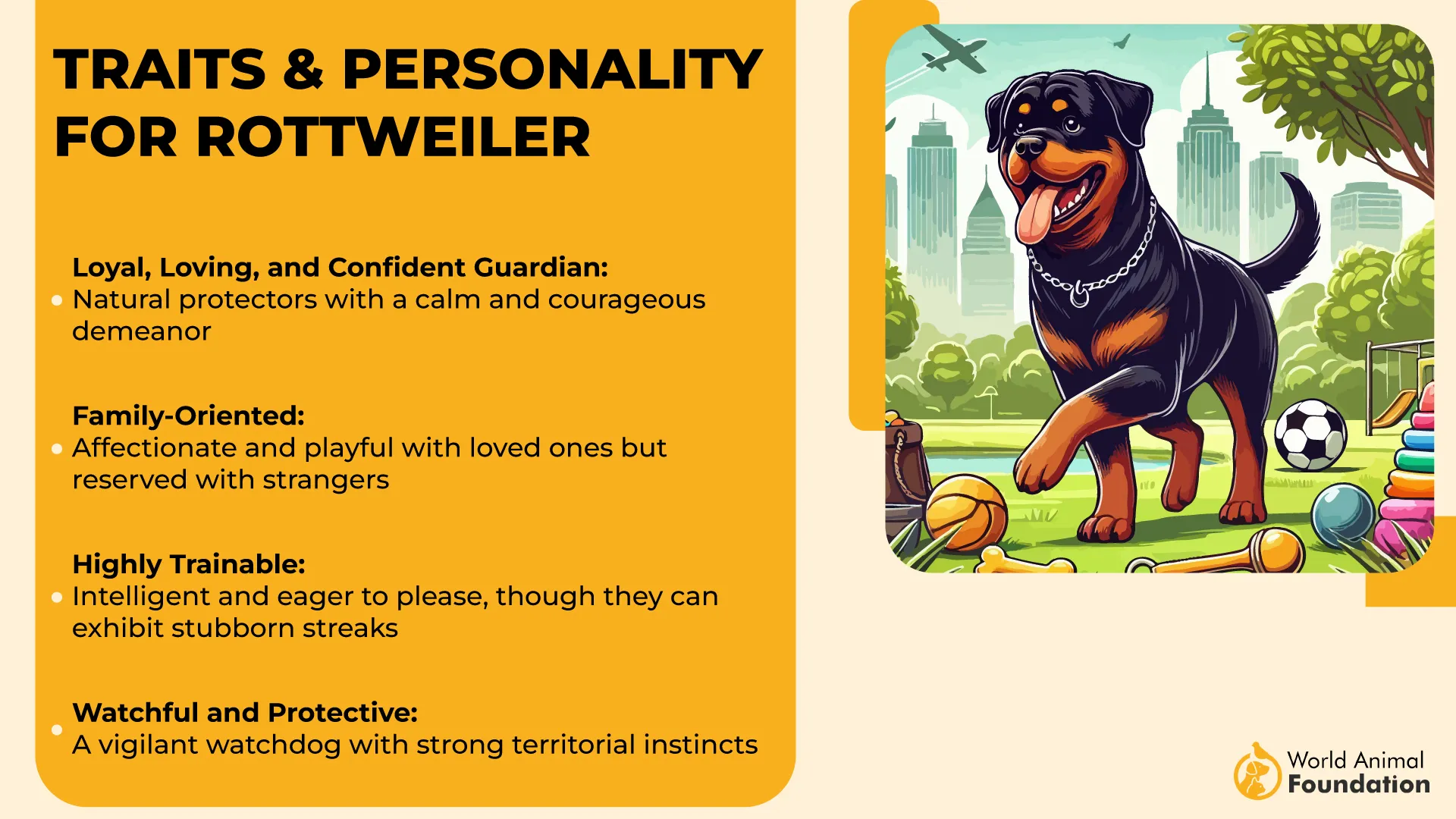
Shedding can surprise first‑time owners. The coat is short but dense, and seasonal changes mean heavier brushing periods. Grooming sessions double as a way to check nails, joints, and overall condition in a breed that carries significant weight.
Health concerns often involve the hips, elbows, and heart function. Regular veterinary checks and careful feeding are as important as training for keeping a Rottweiler comfortable and capable as it ages.
Fun Fact
For centuries, German butchers tied their earnings in small purses to their Rottweilers’ collars—the dogs acted as living, four‑legged safes.
4. Doberman Pinscher
Dobermans don’t wait to be told there’s something outside—they’ve already noticed it. The breed was created in the late 1800s by Louis Dobermann, a tax collector who needed a fast, intelligent protector, and that sharp awareness remains their defining trait. On a dark street, few dogs are more attuned to subtle movement or sound.
WebMD states that they learn at a remarkable pace. This makes training straightforward for owners who stay consistent, but it also means Dobermans need ongoing challenges. Without fresh tasks or drills, their mental energy turns restless.
Exercise is less about raw distance and more about focus. Sprinting sessions, agility work, or scent tracking suit their build and brain. A Doberman that’s allowed to burn energy this way tends to be calmer indoors, but the routine has to stay regular.
Dobermans have minimal grooming needs. A quick weekly brushing handles loose hair, and their thin coat means they’re more likely to need a sweater in winter than an extra bath in summer.
Heart disease, especially dilated cardiomyopathy, is the health issue most tied to the breed. Owners who schedule early screenings often catch it in time to manage it, helping many Dobermans live past a decade.
Fun Fact
During World War II, a Doberman named Kurt alerted Marines to an ambush in Guam, saving lives and becoming the first military dog buried with honors.
5. Giant Schnauzer
The Giant Schnauzer doesn’t just notice movement in the dark—it locks in on it. Bred as a guard and working dog in Germany, it carries that heritage into modern life with an instinctive readiness to investigate anything unusual on late walks. Their sharp, focused energy makes them naturally suited for alert roles.
They are powerful dogs with equally powerful minds, which means training must be deliberate. Early obedience work and structured commands give them a job to focus on, and they excel in advanced training like scent detection and agility drills. Without that direction, they can become pushy or invent their own rules.
Their size demands exercise that matches their strength. Long walks, runs, and tasks like carrying weighted backpacks or pulling carts provide the kind of work they were built to do. Mental challenges—tracking games or obedience routines—keep them engaged as much as the physical work.
The dense, wiry coat protects them in rough weather but needs commitment from owners. Weekly brushing, beard cleaning after meals, and professional stripping or clipping prevent mats and keep the coat manageable.
Owners should keep an eye on joints, thyroid health, and bloat risk. Most live 10–12 years, and a mix of structured exercise and good veterinary care keeps that working drive strong for most of their life.
Fun Fact
Giant Schnauzers were once used to guard breweries in Bavaria, trusted to patrol gates and keep watch through the night.
6. Akita
An Akita on an empty street has a stillness that draws attention. They stand tall, scanning with quiet intensity, and they don’t waste effort on needless movement. That calm watchfulness comes from their roots as hunters and guardians in Japan—a trait that makes them reliable companions when the world feels quiet and tense.
Their independent mind requires a very specific training style. Harsh handling shuts them down, but calm, consistent guidance earns cooperation. Socialization is critical; without it, they can become overly reserved or territorial.
Akitas aren’t dogs for constant motion, but they do need regular structure. One or two solid walks a day, paired with focused play, is enough to keep them steady. They enjoy tasks that engage their intelligence, like puzzle feeders or tracking games, as much as straightforward exercise.
Their thick double coat sheds heavily twice a year. Daily brushing during those periods is essential, while weekly upkeep in between controls loose fur. The coat insulates well, meaning they tolerate cold evening walks with ease.
Potential health concerns include hip dysplasia, thyroid issues, and certain immune disorders. With consistent vet care and proper diet, many Akitas live well into their early teens.
Fun Fact
In Japan, statues of Akitas are often given to new parents or people recovering from illness as symbols of protection and health.
7. Rhodesian Ridgeback
The Rhodesian Ridgeback doesn’t patrol casually—it moves like it’s built to cover ground. Originally developed in southern Africa to hunt and track big game, the breed’s instincts translate into a dog that remains highly aware of its environment, especially in the stillness of night.
Ridgebacks are smart but famously independent. Training needs to start early and stay consistent; too much repetition, and they’ll lose interest. Mixing commands, scent games, and reward‑based sessions helps keep their attention and reinforces boundaries.
Their athletic frame craves exercise that burns energy and keeps their minds sharp. Long, fast walks, runs, and off‑leash sprints in safe spaces are ideal. They’re not constant barkers, but after a day of activity, they settle into calm companionship.
The short coat makes grooming easy, weekly brushing handles loose hair, and baths are rare. What owners watch for instead is bloat, a risk in deep‑chested breeds, which means feeding smaller, spaced meals and limiting exercise right after eating.
Ridgebacks generally live 10–12 years, though joint and thyroid checks are important as they age. Their durability in hot climates also makes them comfortable on warm evening walks.
Fun Fact
The signature ridge of backward-growing hair along a Ridgeback’s spine is unique to the breed and even used as a breed‑standard marker in official registries.
Conclusion
Dogs from strong working lines have long served as guardians, herders, and even police dogs, combining sharp instincts with an ability to form strong bonds with their people. Many of the larger breeds in this list are powerful and highly alert, making them effective guard dogs when properly trained. Their loyalty and protective instincts allow them to recognize potential threats, yet with guidance they can also be excellent companions for families.
Obedience training and consistent physical stimulation are essential for any big dog with guarding instincts. A well‑behaved, well‑directed protection dog is safer for both you and the strangers they meet, and reflective gear or leashes during late walks adds another layer of security. These are not dogs for owners who plan to spend little time with them, they need structure, energy outlets, and trust to thrive.
Most of these breeds are good guard dogs as a last resort, but they are not aggressive by nature. With proper training, they balance their imposing size and keen senses with a steady temperament. They’re well suited to homes that understand their independent streak and high prey drive, and with the right living situation, they become excellent watchdogs and good companions in equal measure.


